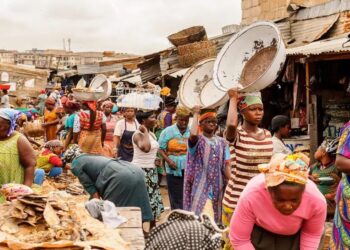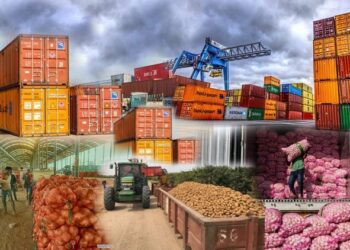Nigerian households are facing significant economic pressure as staple food prices have surged dramatically over the past year.
According to the latest data from the National Bureau of Statistics (NBS), the average prices of essential food items like rice, garri, and tomatoes have soared by approximately 141 per cent from April 2023 to April 2024. This marks the highest yearly increase recorded for this period.
The NBS report highlights a staggering rise in the price of rice, which has climbed from N547 in 2023 to N1,399 in 2024, reflecting an increase of 156 per cent. Garri, a staple particularly vital for low and middle-income earners, has seen its price jump from N363 in April 2023 to N852 in April 2024, marking a 135 per cent increase. On a month-to-month basis, garri prices rose by 13.59 per cent, increasing from N750 in March to N1,554 in April.
The selected food price report by the NBS indicates that the average prices of other essential food items, including onions, beans, bread, beef, and tomatoes, have also seen considerable increases. This surge in food prices has accelerated food inflation to 40.5 per cent in April 2024.
Tomatoes have shown a notable price increase, rising by 17.9 per cent from N960 in March to N1,123 in April. Year-on-year, the price of tomatoes jumped by 132 per cent, up from N485 in the same period last year. Similarly, the price of 1kg of white garri (sold loose) increased by 13.59 per cent from N750 in March to N852 in April, marking a 135 per cent year-on-year increase.
Beans have also experienced significant price hikes. The average price of 1kg of brown beans (sold loose) rose by 125 per cent on a year-on-year basis, increasing from N616 in April 2023 to N1,388 in April 2024. There was also a recorded increase of 12.44 per cent in the price of beans on a month-to-month basis.
The NBS report provides a detailed state and zonal analysis of these price changes. Niger State recorded the highest price for 1kg of local parboiled rice at N1,785, while the lowest price was recorded in Benue State at N994. At the zonal level, the South-West region recorded the highest average price for 1kg of rice at N1,615, followed by the South-South at N1,565. The North-West region recorded the lowest average price at N1,163.
For Garri, the highest prices were recorded in the South-South and South-West regions at N1,031 and N982 respectively, while the North-West region, where Garri consumption is lower, recorded the lowest price at N682.
These significant increases in staple food prices pose serious concerns for food security and the cost of living in Nigeria, particularly for low and middle-income households.
The weakening naira is causing an alarming rise in the cost of food, exacerbating the already dire situation for millions of households across the country.
For the first time in Nigeria’s modern history, images have emerged of Nigerians buying yams cut into pieces because the prices of whole yams have gone beyond the means of ordinary Nigerians.
The reasons are not far-fetched, say economists. For example, dean, and professor at Adeleke University, Professor Tayo Bello, who spoke with NATIONAL ECONOMY on the issue said farmers are simply being driven away from their farmlands without letup by criminals. He noted that the acclaimed food baskets of the nation, including Benue, Plateau, Niger, Taraba are largely occupied by bandits, some of whom demand taxes from farmers. “How can the country produce food under such conditions,”? he wondered.
This is coupled with the fact that on an increasingly yearly basis, the interplay of the opening of the Lagdo Dam in Cameroon and the heavy rains in northern Nigeria ravages millions of hectares of ‘ready for harvest’ crops as they get submerged and condemned to waste, thus exacerbating Nigeria’s food crisis, and by extension, increasing hunger in the land.
Already, the United Nations Resident and Humanitarian Coordinator for Nigeria, Mohammed Fall, has said about 5.9 million Nigerian children face severe food and nutrition crisis, the highest globally.
The dearth of food in the land requires more naira to keep up with one’s normal diet, which spells demand pull food inflation.
A financial economist at Nnamdi Azikiwe University, Dr. Felix Echekoba, noted that the naira has experienced significant devaluation over the past few years, driven by a combination of factors including falling oil prices, reduced foreign exchange reserves, and economic mismanagement.
He said oil, Nigeria’s primary export and source of foreign currency, has seen volatile prices, impacting the nation’s earnings. “Additionally, the global economic downturn and local disruptions have further strained the country’s financial stability,” he said.
Also, Nigeria’s heavy reliance on food imports is a critical factor in the rising food prices linked to the weakening naira. Despite its vast agricultural potential, Nigeria imports a substantial amount of its food, including staples such as rice, wheat, and sugar. When the naira weakens against major currencies like the US dollar, the cost of these imports increases. Importers have to pay more naira for the same amount of foreign currency, and this additional cost is inevitably passed on to consumers.
For instance, the price of rice, a staple food for many Nigerians, has surged to N78,000 as importers struggle with higher costs. Wheat, used in bread and other essential food items, has also seen significant price hikes. The retail price range in Naira for wheat is between N438.66 and N438.66 per kilogram or between NGN 198.94 and N198.94 per pound (lb) in Abuja and Lagos. The depreciation of the naira means that Nigerian consumers are paying more for food items, despite no change in the quantity or quality of these goods.
In April 2024, the average CoHD was highest in the South West at N1,406 per adult per day, compared to N781 per adult per day in the North West.
In recent months, the CoHD has risen faster than general inflation and food inflation. However, the CoHD and the food CPI are not directly comparable; the CoHD includes fewer items and is measured in Naira per day, while the food CPI is a weighted index.
But at the moment, the CoHD would seem to be an understatement when compared to the current reality. At Iyana Ipaja Market on the outskirts of Lagos, four palls of pepper cost N500, according to Catherine, a housewife who spoke with NATIONAL ECONOMY.
Another housewife, Bukola Aswani, related to NATIONAL ECONOMY that the quantity of sweet potatoes she bought at N500 two months ago now costs N1,000. “Where are we going in this country!” she exclaimed. “I don’t know what to do anymore. My salary has become insufficient to feed myself in my own hands and my very own eyes,” Aswani cried out.
The price of a super pack box of Indomie rose from N7,000 six months ago to N17,000 in February and March, and N13,800 currently, said Mark Uduaghan, a single father.
The devaluation of the naira has also contributed to broader inflationary pressures within the economy. As the currency weakens, the cost of living rises, eroding the purchasing power of Nigerians. Salaries and wages have not kept pace with the rate of inflation, leaving many families struggling to afford basic necessities.
“The inflation rate in Nigeria has been hovering above the 30 per cent mark in recent months, exacerbated by the devaluation of the naira. Food inflation, in particular, has been a significant driver of overall inflation, hitting the poorest households the hardest. For many Nigerians, this means having to make difficult choices between food, healthcare, education, and other essential needs,” said the Independent Shareholders Association of Nigeria (ISAN) president, Moses Igbrude.
He added that the rise in food prices due to the weakening naira has severe social and economic consequences. “Higher food prices increase the incidence of malnutrition and food insecurity, particularly among vulnerable populations such as children and the elderly. This, in turn, has long-term impacts on health, education, and productivity, undermining the nation’s development prospects,” he stated.





